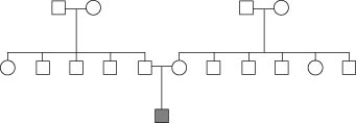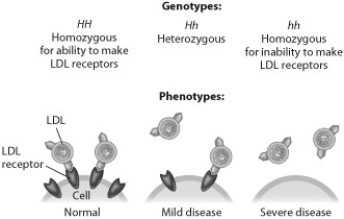A) peas.
B) roses.
C) guinea pigs.
D) fruit flies.
F) B) and C)
Correct Answer

verified
Correct Answer
verified
Multiple Choice
Any gene located on a sex chromosome
A) is called a recessive gene.
B) is called a sex-linked gene.
C) will exhibit pleiotropy.
D) will exhibit codominance.
F) All of the above
Correct Answer

verified
Correct Answer
verified
Multiple Choice
Which of the following statements regarding genotypes and phenotypes is false?
A) The genetic makeup of an organism constitutes its genotype.
B) An organism with two different alleles for a single trait is said to be homozygous for that trait.
C) Alleles are alternate forms of a gene.
D) The expressed physical traits of an organism are called its phenotype.
F) A) and B)
Correct Answer

verified
Correct Answer
verified
Multiple Choice
The presence of AB blood type illustrates the principle of
A) incomplete dominance.
B) codominance.
C) pleiotropy.
D) polygenic inheritance.
F) All of the above
Correct Answer

verified
Correct Answer
verified
Multiple Choice
What is the most likely explanation for the occurrence of an X-linked genetic disorder in the boy at the bottom of the pedigree shown? 
A) The boy inherited this allele from his father only.
B) The boy inherited this allele from his mother only.
C) The boy inherited the kind of allele that skips every other generation.
D) The boy has a new mutation for the disorder.
F) A) and C)
Correct Answer

verified
Correct Answer
verified
Multiple Choice
Cats normally have a total of 18 toes, 5 on each front paw and 4 on each back paw. But some cats express the dominant phenotype for polydactyly, which results in the development of extra toes on one or more paws. Jake, a Canadian tabby cat, has 28 toes and is recognized by the Guinness Book of World Records as the cat with the most toes. Suppose that Jake mates with a female cat, Lucy, who has 18 total toes. Over several years, they have multiple litters and a total of 16 kittens (10 males and 6 females) . The total number of toes on each kitten ranges from 21 to 25. -One of Jake and Lucy's kittens mates with another cat that has 18 total toes. What is the probability that one of their offspring would have 18 total toes?
A) 100%
B) 75%
C) 50%
D) 0%
F) A) and D)
Correct Answer

verified
Correct Answer
verified
Multiple Choice
You are looking at an unknown cell under a microscope that has 22 chromosomes plus 2 X chromosomes. Which of the following is the most likely identity of this cell?
A) a skin cell from a human female
B) an egg from a human female
C) an epithelial cell from a male chicken
D) an eye cell from a female grasshopper
F) A) and C)
Correct Answer

verified
Correct Answer
verified
Multiple Choice
Which of the following terms refers to a situation where a single phenotypic character is determined by the additive effects of two or more genes?
A) incomplete dominance
B) codominance
C) pleiotropy
D) polygenic inheritance
F) A) and D)
Correct Answer

verified
Correct Answer
verified
Multiple Choice
Justin has type A blood and his wife Brittany has type B blood. Justin's parents both have type AB blood, and Brittany's parents also both have type AB blood. What are the chances that Justin and Brittany's son Theodore has type A blood?
A) 100%
B) 75%
C) 25%
D) 0%
F) All of the above
Correct Answer

verified
Correct Answer
verified
Multiple Choice
In some cats, black coat color (B) is dominant over brown (b) and a striped fur pattern (S) is dominant over a marbled fur pattern (s) . You rescued a black striped cat from an animal shelter but could not determine its exact genotype. To do so, you mated the cat with a brown marbled cat. The mating produced 3 brown marbled, 2 brown striped, 2 black marbled, and 3 black striped. Immediately, you concluded the genotype of your rescued cat was
A) BBSS.
B) BBSs.
C) BbSS.
D) BbSs.
F) A) and B)
Correct Answer

verified
Correct Answer
verified
Multiple Choice
Most genetic disorders of humans are caused by
A) multiple alleles.
B) recessive alleles.
C) a mutation that occurs in the egg, sperm, or zygote.
D) dominant alleles.
F) A) and C)
Correct Answer

verified
Correct Answer
verified
Multiple Choice
Cats normally have a total of 18 toes, 5 on each front paw and 4 on each back paw. But some cats express the dominant phenotype for polydactyly, which results in the development of extra toes on one or more paws. Jake, a Canadian tabby cat, has 28 toes and is recognized by the Guinness Book of World Records as the cat with the most toes. Suppose that Jake mates with a female cat, Lucy, who has 18 total toes. Over several years, they have multiple litters and a total of 16 kittens (10 males and 6 females) . The total number of toes on each kitten ranges from 21 to 25. -If we use the letter P to represent the polydactyly gene, what is Jake's genotype?
A) PP
B) Pp
C) pp
E) A) and C)
Correct Answer

verified
Correct Answer
verified
Multiple Choice
Below are two statements. Which (if any) applies to the law of segregation? Which (if any) applies to the law of independent assortment? I: Phenotypes for long tails and big eyes are inherited separately in lab mice. II: A baby mouse inherits a maternal red-eye allele and a paternal black-eye allele.
A) I: segregation; II: independent assortment
B) I: independent assortment; II: segregation
C) I: segregation; II: segregation
D) I: independent assortment; II: independent assortment
F) None of the above
Correct Answer

verified
Correct Answer
verified
Multiple Choice
The phenotypic ratio resulting from a dihybrid cross of two heterozygote individuals showing independent assortment is expected to be
A) 1:2:1
B) 3:1
C) 9:1:1:3
D) 9:3:3:1
F) All of the above
Correct Answer

verified
Correct Answer
verified
Multiple Choice
A testcross is
A) a mating between an individual of unknown genotype and an individual homozygous recessive for the trait of interest.
B) a mating between an individual of unknown genotype and an individual heterozygous for the trait of interest.
C) a mating between two individuals heterozygous for the trait of interest.
D) a mating between two individuals of unknown genotype.
F) C) and D)
Correct Answer

verified
Correct Answer
verified
Multiple Choice
According to this figure, heterozygotes for this form of hypercholesterolemia suffer from the disease because they 
A) produce an abnormally shaped LDL receptor.
B) don't produce any LDL receptors.
C) produce too many LDL receptors.
D) don't produce enough LDL receptors.
F) B) and D)
Correct Answer

verified
Correct Answer
verified
Multiple Choice
If independent assortment did not occur, which of the following would be true?
A) Genes for two different traits would be inherited together as a pair.
B) Meiosis II would not be required to produce gametes, as meiosis I would be sufficient.
C) A dihybrid cross of heterozygous individuals would yield four different phenotypes.
D) Each sperm and egg would carry more than one allele for a specific gene.
F) A) and C)
Correct Answer

verified
Correct Answer
verified
Multiple Choice
If A is dominant to a and B is dominant to b, what is the expected phenotypic ratio of the cross AaBb × AaBb?
A) 16:0:0:0
B) 8:4:2:2
C) 1:1:1:1
D) 9:3:3:1
F) B) and D)
Correct Answer

verified
Correct Answer
verified
Multiple Choice
The chromosome theory of inheritance states that
A) chromosomes that exhibit mutations are the source of genetic variation.
B) the behavior of chromosomes during meiosis and fertilization accounts for patterns of inheritance.
C) the behavior of chromosomes during mitosis accounts for inheritance patterns.
D) humans have 46 chromosomes.
F) All of the above
Correct Answer

verified
Correct Answer
verified
Multiple Choice
You prepare a human karyotype. Upon analysis, you find 22 pairs of chromosomes that are each of approximately equal length and also a single pair that has one chromosome longer than the other. What can you conclude from this information?
A) The organism that this cell came from is likely a female.
B) The organism that this cell came from is likely a male.
C) The organism that this cell came from has a genetic disease.
D) This cell is likely haploid.
F) A) and B)
Correct Answer

verified
Correct Answer
verified
Showing 41 - 60 of 76
Related Exams